It's about getting fitter, happier and stronger with expert methods used for profession athletes for Aerobic and Anaerobic training, by incorporating "Kettle-bell or Olympic style weight lifting" with other sports i.e.: Sprinting, Tennis, Golf, Boxing or learning Karate for fun & self defense in one of the most scientific and effective styles in the world, namely: SHOTOKAN
You might have heard about traditional martial arts, kick-boxing evolving to MMA, or Power training, Olympic Weight Lifting, Athletics & Gymnastics evolving to X-FIT. With over 25 years of experience, in martial arts and athletics and over 10 years experience in weight training; I've come up with my own branding, and I call it: POWER-FIT-KARATE or PFK
WHAT IS IT ABOUT?
It's about getting fitter, happier and stronger with expert methods used for profession athletes for Aerobic and Anaerobic training, by incorporating "Kettle-bell or Olympic style weight lifting" with other sports i.e.: Sprinting, Tennis, Golf, Boxing or learning Karate for fun & self defense in one of the most scientific and effective styles in the world, namely: SHOTOKAN
You might have heard about traditional martial arts, kick-boxing evolving to MMA, or Power training, Olympic Weight Lifting, Athletics & Gymnastics evolving to X-FIT. With over 25 years of experience, in martial arts and athletics and over 10 years experience in weight training; I've come up with my own branding, and I call it: POWER-FIT-KARATE

Concise Power lifting Characteristics
Powerlifting, a strength sport where you compete in the squat, bench press and deadlift, allows you to build muscle and burn fat. Powerlifting, like other forms of heavy resistance training, strengthens your skeleton and reduces your risk of injury in other sports and activities. While the rules for the powerlifts remain specific, the general benefits of powerlifting go far beyond conventional lifting. Consult a health care practitioner before beginning any strength training program.
Skeletal Health
Osteoporosis afflicts one out of every five women. Fortunately, resistance training can combat the onset of osteoporosis. In a 10-year review of literature published in "Medicine & Science in Sports & Exercise" in 1999, it was shown that resistance training specifically increases bone mineral density. It was further shown that intense resistance training, such as powerlifting, decreases numerous risk factors for osteoporosis by increasing strength and bone mass.
Athletic Ability
Many of the activities in powerlifting improve other abilities, including speed and vertical jump. In a 2004 study published in the "British Journal of Sports Medicine," a direct correlation between squat strength and sprint speed was shown. There was also a direct correlation between squat strength and vertical leap. So if you want to run faster or jump higher, build a bigger squat through powerlifting. The strength of your back contributes to many other activities, including martial arts, wrestling and fighting. There are few activities that being strong does not help in one way or another.
Fat Loss
Powerlifting is a very intense form of exercise and burns a great many calories. One of the benefits of intense training is not just the calories you burn while training, but the long-term effect this has on your metabolism. In a 1994 study published in the "American Journal of Clinical Nutrition," study participants undergoing resistance training increased their caloric demands over a 24-hour period by 15 percent. Resistance training such as powerlifting has long been shown to be effective for fat loss.
Concise Shotokan Characteristics
Shotokan training is usually divided into three parts: kihon (basics), kata (forms or patterns of moves), and kumite (sparring). Techniques in kihon and kata are characterised by deep, long stances that provide stability, enable powerful movements, and strengthen the legs. Shotokan is regarded as a dynamic martial art as it develops anaerobic, powerful techniques as well as developing speed. Initially strength and power are demonstrated instead of slower, more flowing motions. Those who progress to brown and black belt level develop a much more fluid style that incorporates grappling, throwing and some aikido-like techniques, which can be found even in basic kata.[6] Kumite (fighting) techniques are practised in the kihon and kata and developed from basic to advanced levels with an opponent.
KARATE ELABORATIONS
Speed-ball training:
Any type of boxing, be it kick or punch, is not just about how hard you hit, it's also about how fast and accurate you hit and dodge the returns.
In Karate often the accuracy of a one punch is practiced, in wing-tsun they practice a barrage of fast punches and in western boxing a bit of both.
Speed-ball training is one of the best exercises to both build a good rhythm and focus while learning how to slip the jabs. It also helps a lot with coordination. Power is not the focus.(No slugging here!)
A powerful knock-out punch is often followed up after a good combinations of fast, slick punches.
From the health aspect, speed-ball training is also a good cardio training and not as boring as repetitively monotonous jogging, step or treadmill run.
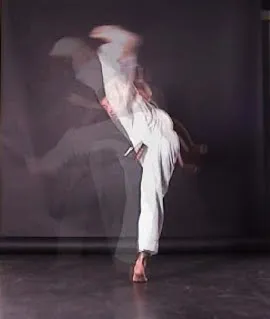
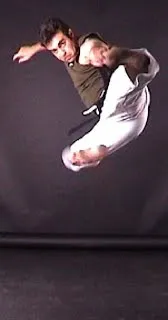

Since snap-kick (Yoko Geri Keage) and its importance in the fundamental speed kicks
In many different Karate styles and classes that I've been to, I've noticed that very often people are confused when it comes to the side-snap kick or Yoko-Geri-Keage.
Very often I've also seen that even the instructor can not break down this technique correctly to clear the confusion for the students.
That's why you hardly see anyone using this kick effectively in the tournaments, as they never understood how to use the technique effectively.
Yoko-Geri-Keage translated side snap kick, it is not necessarily only a snap kick, as it starts as a snap kick and it could evolve into "Yoko-Geri-Kekomi", translated thrust kick.
The difference between these two kicks is at the start of the kick.
"Keage" starts without twisting of the hips by raising the knee and opening as an upwards strike.
Only if the target is met, it should be retreated by pulling back with fast reflex (Ekitte); pretty much like a jab.
If the target cannot be reached within the range of the curve, it could incorporate the twist of the hip and thrusting forwards after it finishes the optimum upwards travel of the knee, pointing at the target.
This would be more surprising than a full Kekomi kick, as you would be signalling your opponent by twisting your hips.
On the other hand Keage lacks power in comparison to Kekomi.
Furthermore, one can call the Yoko-Geri-Keage as the basis of three kicks. After he upward travel before opening from the knee, not only it can transform to Yoko-Geri-Kekomi but also can transform to "Mawashi" round-house or 'Ura-Mawashi-Geri' back round-house and shoot!
As far as the rest of the fundamental kicks are concerned, "Yoko-Geri-Keage" cannot transform into "Ushiro-Geri" back kick and "Mae-Geri" the front kick.
The front kicks: Mae-Geri Kekomi and Keage work in a different way!
When comparing the Kekomi Mae-geri with Yoko-geri, the difference is that in Mae-Geri you cant engage your hip at the beginning and the hip engagement takes place after cocking the knee pointing at the target.
Mae-Geri-Kekomi is conceptually similar to Yoko-Geri-Keage transforming to Kekomi after the cocking and pointing the knee at the target.
Trickier kicks:
There is also a transforming kick that sometimes is referred to as: "Mae-Mawashi geri". This is a very good technique to throw off your opponent.
How it works is that you cock your knee aiming at "Gedan" below the belt, "Chudan" around the belt area or "Jodan" above the belt and then instead of just twisting the hips for the "kekomi", you also pivot your foot from 45 to 135 degrees so you could get into a Yoki-Geri-Keage chambered stance.
As discussed before, from this point you can throw a Mawashi, Ura-Mawashi or even a Yoko Geri (Keage or Kekomi)!
If you transform it to "Mawasshi", the surprise element is very effective and it's a lot faster than a full Mawashi-Geri, but the power will be compromised.
A Mawashi-Geri which commercially often referred to as Muay-Thai kick is a power kick but the second slowest in kicking strikes. One could call it a Kekomi-Mawashi. (but I have never seen it to be referred to as such.)
The reason for that is that you are not engaging your hip during the execution of the technique but you lock the hip and twist the whole body towards your target.
To sum up I would assume perhaps that is the reason that almost all the kicks that are practiced in the Shotokan katas are side-snap kick, or Yoko-Geri-Keage.
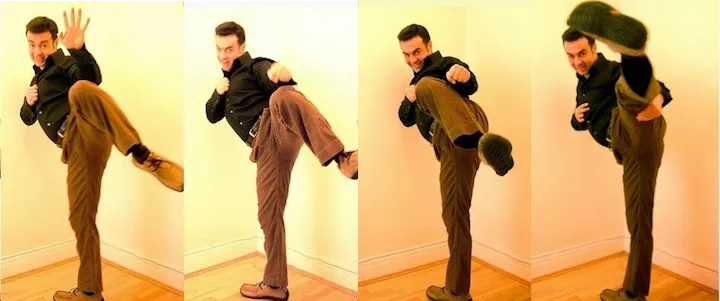
Jumping back round-house, the most spectacular kick
"Ushiro-Mawashi-Tobi-Geri" kick is the most spectacular, advanced kick that is used in many martial arts movies. The highest promoter of this kick is Jean-Claude-Van-Damme.
After his box-splits this is the kick he often choreographed in his fight scenes.
As much as this kick is not really effective in tournaments or sparing, there are many elements of accuracy, athleticism and flexibility needed to be well executed.
Although when mastered this complex technique could also be used in practical cases as an element of surprise, after a well executed combination of direct strikes, for a good finish.
Unlike most students wanting to impatiently go straight to the jumping kicks, it is absolutely necessary to first master all the basic kicks on the floor before advancing to jump kicks.
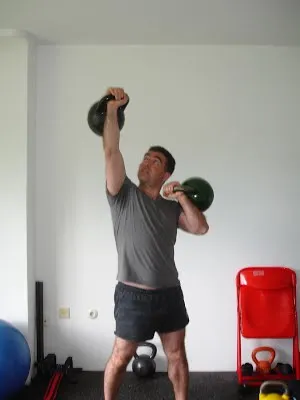
Kettle bells
Kettlebell fitness workouts allow you to get better at things you didn’t even expect. Kettlebells proponent Pavel Tsatsouline, a former Soviet Special Forces training instructor, writes in “Enter the Kettlebell” that his students tell him that they “powerlift heavier, hit harder, run faster, bend nails and so on -- just from lifting kettlebells.” You also can take the basic kettlebell moves and combine them into a workout to reach your specific fitness goals
The RKC Rite of Passage
In “Enter the Kettlebell,” Pavel provides a fitness workout called the RKC Rite of Passage training plan. It's designed to be an all-purpose, challenging program to lead to overall fitness. This plan, with its seven-day framework, allows you to rest on Fridays and Sundays. Mondays involve clean and presses, or military presses. On Tuesdays, you get to do whatever you want, ideally keeping it easy. On Wednesday and Thursday, you can do any or all of the following: cleans alternated with getups, swings and snatches. Saturday is your hard workout day, when you perform clean and press ladders, and timed hard swings.
Squats
The barbell squat builds and tests the strength of your legs and core. Squatting deeply requires both flexibility and an erect posture --- leaning forward or rounding your back exposes you to injury. The squat does not build just strength, it also builds explosive power that improves both your sprint times and vertical jump, according to a 2004 study published in the "British Journal of Sports Medicine." Never squat outside of a squat rack or power cage, and always hold the bar firmly on your upper back.
Deadlift
The deadlift recruits muscles from your upper and lower back, your hips, legs and core, all while testing your grip. Both the conventional deadlift, in which you pull the bar from the ground with your feet shoulder-width apart, and the sumo deadlift, in which your feet are spread wide, build strength and power. The sumo-style deadlift works your legs more and your lower back less than the conventional deadlift, according to a 2000 study published in "Medicine and Science in Sports and Exercise."
Olympic weight lifting
The snatch, and the clean and jerk generate more power than any other exercises, according to John Garhammer, Ph.D., a professor of biomechanics at California State University, Long Beach. Strength exercises the squat, bench press and deadlift allow you to use more weight than other lifts, and remain the prime strength-building exercises. The snatch, and the clean and jerk take years to develop technical mastery, but the powerlifts develop more quickly. All five lifts build strength and power while transforming your physique. Consult a health care professional before beginning any strength-training program.
Snatches
The snatch involves pulling a weight overhead in a single movement, and bending your knees to catch it. The strength with which you pull the weight and the speed with which you get underneath the bar make this a complex lift, and it is the first lift contested in the Olympic sport of weightlifting. Much of the power in this lift is generated by the speed with which you straighten your legs, according to a 2002 study published in the "Journal of Strength and Conditioning Research
Clean and (Squat)-Jerk
The clean and jerk requires you to pull a barbell to your shoulders while bending your knees to catch it. You land in the bottom position of a front squat, stand erect and then thrust the barbell overhead while moving your feet apart to catch the weight. This is the second lift contested in the Olympics. According to a 1980 study published in "Medicine and Science in Sports and Exercise," the jerk generates more power than any lift ever tested.
COURSE STRUCTURE & LEVELS

Basic Level (White to Purple belt)
Stances (Dachi)
Blocks (Uke)
Strikes (Zuki & Geri)
Combination techniques (Kata):
Hian Shodan
Hian Nidan
Hian Sandan
Hian Godan
Hian Yodan
Pre programmed step sparing 4,3,1
Gohon Kumite
Sanbon kumite
Ippon Kumite
Fitness Focus
Joint health by full range movement exercises
Sprinting
Vertical jump
Flexibility & Power (Dynamic, Isometric)
Kettle-bell training
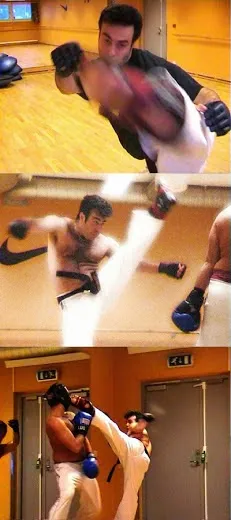
Intermediate level (Kyu 3 to Dan1)
Sparing:
Jiyu Ippon Kumite (Used for Self defense applications)
Jiyu Kumite (Free fight)
Katas:
Basai-Dai
Kanku-Dai
Intermediate techniques:
Spinning & advanced strikes
Kakatu, Ura-mawashi, Ushiro mawashi
Fitness focus (Power lifting)
Squats & variations
Dead-lifts & variations
Over-head Presses & variations
Pull and push-ups & variations

Advanced level ( Dan-1 Dan-3)
Sparing:
Jiyu Kumite
Competition Sparing
Kick boxing (ISKA, K1)
Advanced self defense & tactical applications
Advanced Techniques:
Locks, Chokes, Sweeps, Throws
Advanced kicks and jump strikes
Tobi geri , zuki
Stand up and ground sparing
Katas:
Tekki Shodan
Tekki Nidan
Tekki Sandan
Other selected "practical" Katas from 26 shotokan katas
Fittness focus
Ballistic stretches
Olympic weight lifting for athletes, integrating with sprints, jumps & spins
Snatch
Clean
Squat Jerk